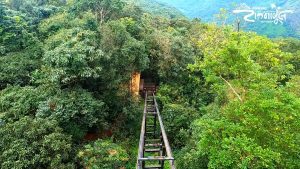FUNICULARS
Safe, reliable, fast and eco-friendly
- WINTER SPORTS
- TOURISM
- URBAN
- HILL & MOUTAIN
- WINTER SPORTS
- TOURISM
- URBAN
- HILL & MOUTAIN
Funicular
Economical mode of transportation
Given that Funicular train projects are built in a straight line over a hilly terrain, it also results in lower land acquisition costs. Hence, despite having a higher cost of construction per km than roadways, Funicular projects’ construction cost may happen to be economical than roadways.
Faster mode of transportation
Owing to the vertical mode of transportation, Funicular have an advantage over roadway projects where Funicular can be built in a straight line, over a hilly terrain thus cutting the time required to travel.
Environmentally friendly
Lowest or nil dust and carbon emissions. Material containers can be designed so as to rule out any soiling of the environment.
Last mile connectivity
Funicular projects can transport 20 passengers along with 2000kg load per trip to the remotest hilly area
Safe, Reliable, Fast and Eco Friendly
PANEW funiculars run on tracks. The line of a funicular is very flexible, from straight to curved, uphill or downhill. Car capacity also varies, and the individual cars can be combined to form trainsets. With line speeds of up to 14 m/s, funiculars are the fastest ropeway system of all. They can be designed to operate with the high levels of availability expected of a public transport system.
TERRAIN:
- FOREST
- HILLY
- HEAVY RAINFALL
- STROMY WINDS
- FOREST
- HILLY
- HEAVY RAINFALL
- STROMY WINDS
- Length in m 300
- Height difference 200
- Slope in degrees 40
- p/hr 600
- kW1X12
- Number of cabins1
- Load Carrying Capacity2000kg
Safe, Reliable, Fast and Eco Friendly
PANEW funiculars run on tracks. The line of a funicular is very flexible, from straight to curved, uphill or downhill. Car capacity also varies, and the individual cars can be combined to form trainsets. With line speeds of up to 14 m/s, funiculars are the fastest ropeway system of all. They can be designed to operate with the high levels of availability expected of a public transport system.
TERRAIN:
- FOREST
- HILLY
- HEAVY RAINFALL
- STROMY WINDS
- Length in m 300
- Height difference 200
- Slope in degrees 40
- p/hr 600
- kW1X12
- Number of cabins1
- Load Carrying Capacity2000kg
Safe, Reliable, Fast and Eco Friendly
PANEW funiculars run on tracks. The line of a funicular is very flexible, from straight to curved, uphill or downhill. Car capacity also varies, and the individual cars can be combined to form trainsets. With line speeds of up to 14 m/s, funiculars are the fastest ropeway system of all. They can be designed to operate with the high levels of availability expected of a public transport system.
- Length in m 300
- Height difference 200
- Slope in degrees 40
- p/hr 600
- kW1X12
- Number of cabins1
- Load Carrying Capacity2000kg
TERRAIN:
- FOREST
- HILLY
- HEAVY RAINFALL
- STROMY WINDS
MAJOR FACTORS DRIVING PARWATMALA – FUNICULAR TRAIN INFRASTRUCTURE
Economical mode of transportation
Given that Funicular train projects are built in a straight line over a hilly terrain, it also results in lower land acquisition costs. Hence, despite having a higher cost of construction per km than roadways, Funicular projects’ construction cost may happen to be economical than roadways.
Faster mode of transportation
Owing to the vertical mode of transportation, Funicular have an advantage over roadway projects where Funicular can be built in a straight line, over a hilly terrain thus cutting the time required to travel.
Last mile connectivity
Lowest or nil dust and carbon emissions. Material containers can be designed so as to rule out any soiling of the environment.
Environmentally friendly
Funicular projects can transport 20 passengers along with 2000kg load per trip to the remotest hilly area
MAJOR FACTORS DRIVING PARWATMALA – FUNICULAR TRAIN INFRASTRUCTURE
Economical mode of transportation
Given that Funicular train projects are built in a straight line over a hilly terrain, it also results in lower land acquisition costs. Hence, despite having a higher cost of construction per km than roadways, Funicular projects’ construction cost may happen to be economical than roadways.
Faster mode of transportation
Owing to the vertical mode of transportation, Funicular have an advantage over roadway projects where Funicular can be built in a straight line, over a hilly terrain thus cutting the time required to travel.
Last mile connectivity
Lowest or nil dust and carbon emissions. Material containers can be designed so as to rule out any soiling of the environment.
Environmentally friendly
Funicular projects can transport 20 passengers along with 2000kg load per trip to the remotest hilly area
Funicular
Developing an efficient transport network is a big challenge in hilly areas. The rail and air transport networks are limited in these areas, while the development of road network has technical challenges. In this backdrop, Ropeways and Funicular way have emerged as a convenient and safe alternate transport mode.
“Parvatmala” will be a preferred ecologically sustainable alternative in place of conventional roads in difficult hilly areas, the idea is to improve connectivity and convenience for commuters, besides promoting tourism. This may also cover congested urban areas, where conventional mass transit system is not feasible.


